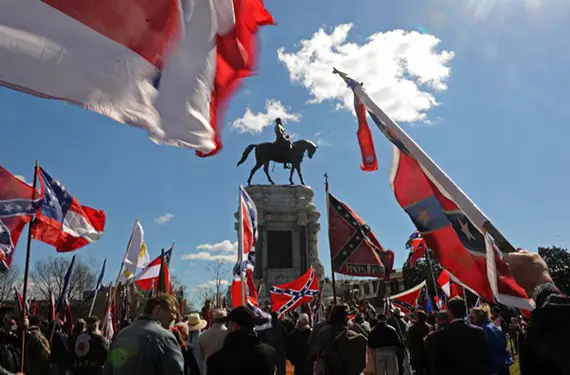Following the events of Charlottesville—in which Neo-Nazis and white nationalists used the issue on the removal of a Confederate monument as a guise to collectivize and march Virginia city in a show of intimidation that eventually ended in the murder of a counter-protester—dozens of cities across the nation have either begun taking down their monuments or are seriously considering it in conjunction with their citizens’ wishes.
There are about seven hundred Confederate monuments throughout the country, with most concentrated in the southern states, according to The Washington Post. Before dismantling of any of these monuments can even begin, it requires the American people to revisit the history surrounding the support, motivation and events coinciding with the erection of these monuments following the end of the war, as well as the legislation put in place in states like Texas to help keep them intact.
The end of the Civil War required leaders of the Union to reconsider what it meant to be a united nation and to focus on repairing the rifts that four years of conflict left between those on both sides of the Mason-Dixon line. Thus the age of Reconstruction was ushered in, in which both the north and south had to reconcile the differences in ideology and help re-establish themselves as partners in issues of domestic politics, economics and human rights following the abolishment of slavery.
Though all African-Americans were effectively free people following the war, their civil liberties were still threatened as white lawmakers sought to solidify their dominance in society by disenfranchising black voters with impossible literacy tests, as well as the systematic segregation of white and black citizens throughout all levels of society.
These customs and laws were codified as early as the 1880s and were a part of some state constitutions that formed what became known as the Jim Crow laws. This argument of “separate but equal” accommodations and access to education, politics and opportunity were equal in language alone—many of the aspects of post-Reconstruction life for black citizens paled in comparison to those afforded to whites.
The Jim Crow laws were constructed to keep those that had power before, in power. As with many socially progressive moments in history, when civil rights are expanded to one marginalized group, it is often met with backlash by those that seek to retain their hold on power.
Understanding the political climate and the lengths that white citizens went to at the time to establish themselves as power-holders is important to understanding the context surrounding the push to honor the Confederacy, its soldiers and the physical manifestations of these remembrances in monuments by those that lost the war. As many white southerners saw the expansion of liberty finally granted to their black counterparts, they felt their way of life, establishment of power and even the superiority of their race were being threatened.
It’s no coincidence that the majority of Confederate monuments were established around the turn of the century, during the period in which black people were being legally stripped of the rights they were supposed to have been granted as free people.
What little power that was ceded to these African-American groups was given begrudgingly and with little cooperation. Racism continued to be an issue—especially with the onset of the Ku Klux Klan—as white people had difficulty coming to terms with the fact that those they had previously subjugated for their personal gain were now walking amongst them as free people in society.
Organizations such as the United Daughters of the Confederacy—a hereditary group established to preserve the history and memory of the battles and southerners that fought in them—began to advocate for the erection of these monuments. Using bake sales and other means to raise money within their communities, the UDC had a huge part in garnering the monetary support needed to place these monuments within town centers throughout the South.
The monuments, either dedicated to specific generals or to all soldiers of the Confederacy that often are engraved with buzz words like “heroes” and “states’ rights,” ignore the real implications of the war between the states. The flurry of monuments erected were direct responses to the changes in racial stations of society; they are tangible and ever-present glorifications of an ideology based in white supremacy that sought to serve as constant reminders to people of color that, although the Confederacy may have lost the war, their white ideals were far from lost.
These monuments were placed in central and important parts of their towns and cities, such as courthouse lawns and city parks, where many remain today. Texas, specifically, hosts many of its Confederate statues on their courthouse grounds—a place that is supposed to be equitable and fair to the entirety of its people.
What many don’t realize is that, over the years, Texas has made it illegal and very difficult for the removal of some of its Confederate statues. Though many cities, and the citizens that dwell within them, have protested and called for the removal of these monuments throughout Texas, they fail to realize that many of these are property of the state and would result in steep repercussions if removed without permission.
The Texas Code of Law established a Texas Historical Commission in the 1969 Antiquities Code of Texas, which was enacted to protect sites and monuments of historical and archaeological import. A huge project underneath this code is the Historic Courthouse Protection Program, which enabled the state to help provide monetary support to cities across Texas with restoring their historic courthouses and the grounds in which they stand, alternatively protecting the Confederate monuments that preside on the grounds as well.
In many cases, easements—or the right to use land by the state in exchange for money—were placed on these historic courthouse restorations, making the issue of the property and the monuments on them even more complicated.
For instance, the Denton County Courthouse has a Confederate statue at the forefront of it’s property, and is a highly contentious issue in which students of both universities in Denton—Texas Women’s University and the University of North Texas—have protested the presence of the statue for years, and continue to do so.
But because of the easement placed on the property by the state of Texas, the city of Denton can do little by way of removing, or even thinking of removing, a historical monument without the permission of the state. In fact, if either the city, or an individual citizen, were to remove the monument without consent of the state, they would be prosecuted under an enforcement clause that would result in up to $1,000 per day that the monument remains missing from the courthouse lawns.
What this means, for people on both sides of the issue, is that simple protestation of these monuments or the forcible removal thereof are not enough to solve the problem; it requires a fundamental understanding and change in the law as it currently stands. Without the cooperation of the state as a whole, many of these monuments will remain standing. It’s an ingenious way of ensuring the preservation of a history of a certain group of people—white Texans—through legislative, monetary coercion.
It seems as though these codes are selectively enforced as well, as Section 442.0084 calls for the Texas Historical Commission to ensure “equitable representation of all Texans” such as women, Native Americans, black and Hispanic people important to the state’s history in its “monuments on land owned by the state.” There are, however, an inordinate amount of monuments erected to represent men of white-European descent, especially those that sided with the Confederacy, with hardly any to match for those of a different color, creed or gender.
These points made about history and the legislation that currently surrounds the contended monuments in many states, not just Texas, are not intended to persuade an individual to either condemn the monuments or support them. It is simply in the interest of the citizens to better understand the context from which these statues and monuments came, and how they are still protected under law, in order to make informed and rational decisions for the fate of these monuments in the future. There is, however, no more room in this country for hate, ignorance, bigotry and false racial superiority; that much is clear.

















